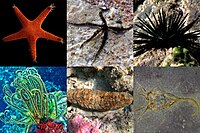
Multivariate morphometric investigation to delineate species diversity and stock structure of mud crab Scylla sp. along the coastal regions of Bangladesh
Sign Up to like & getrecommendations! Published in 2020 at "Aquaculture and Fisheries"
DOI: 10.1016/j.aaf.2020.03.010
Abstract: Abstract Despite the importance of mud crab species (genus Scylla) in both coastal aquaculture and artisanal fisheries, knowledge of the species diversity and stock structure of mud crab population for their sustainable management across the… read more here.
Keywords: mud crab; multivariate; stock structure; mud ... See more keywords

Distribution of abalone egg-laying hormone-like peptide in the central nervous system and reproductive tract of the male mud crab, Scylla olivacea.
Sign Up to like & getrecommendations! Published in 2019 at "Acta histochemica"
DOI: 10.1016/j.acthis.2018.11.004
Abstract: The mud crab, Scylla olivacea, is a high value economic marine animal in Thailand. However, collection of these crabs from natural habitat for local consumption and export has caused rapid population decline. Hence, aquaculture of… read more here.
Keywords: scylla olivacea; crab; mud crab; egg laying ... See more keywords

Performance evaluation of mud crab Scylla olivacea (Herbst, 1896) co-culture with different fish species in confined brackishwater ponds
Sign Up to like & getrecommendations! Published in 2020 at "Aquaculture"
DOI: 10.1016/j.aquaculture.2020.735125
Abstract: Abstract We examined co-culture of Scylla olivacea with different brackishwater fishes in confined earthen ponds to promote livelihood options for coastal farmers. Culture duration was 240 days. Significantly higher (p read more here.
Keywords: scylla olivacea; evaluation mud; mud crab; performance evaluation ... See more keywords

SpICAD contributes to WSSV infection by suppressing apoptosis in mud crab (Scylla paramamosain)
Sign Up to like & getrecommendations! Published in 2021 at "Aquaculture"
DOI: 10.1016/j.aquaculture.2021.736449
Abstract: Abstract ICAD is the inhibitor of caspase-activated deoxyribonuclease and has been widely investigated for its apoptotic regulatory function in higher animals, whereas apoptosis is tightly relevant to immune defense. However, the involvement of ICAD during… read more here.
Keywords: spicad; infection; mud crab; apoptosis ... See more keywords

Chinese gallnut (Galla chinensis) against Vibrio parahaemolyticus: In vitro activity and the use of medicated bath method to treat infected mud crab Scylla paramamosain
Sign Up to like & getrecommendations! Published in 2021 at "Aquaculture"
DOI: 10.1016/j.aquaculture.2021.736632
Abstract: Abstract Natural herbs, especially traditional Chinese herbs (TCHs), are gaining attention as alternatives to treat bacterial diseases in aquaculture. In order to assess the possibility of using TCHs to cure bacterial diseases of mud crab… read more here.
Keywords: vibrio parahaemolyticus; crab scylla; mud crab; galla chinensis ... See more keywords

Dietary zinc levels affects lipid and fatty acid metabolism in hepatopancreas of mud crab (Scylla paramamosain)
Sign Up to like & getrecommendations! Published in 2021 at "Aquaculture"
DOI: 10.1016/j.aquaculture.2021.737274
Abstract: Abstract This study investigated the influences of dietary zinc (Zn) on lipid and fatty acid metabolism of Scylla paramamosain. Three diets containing analyzed Zn levels including 44.5 (low Zn), 68.5 (medium Zn) and 254.7 (high… read more here.
Keywords: mud crab; acid metabolism; fatty acid; lipid fatty ... See more keywords

Sterol regulatory element binding protein-1: Molecular cloning, tissue distribution and gene expression level in response to nutritional regulation in mud crab, Scylla paramamosain.
Sign Up to like & getrecommendations! Published in 2018 at "Biochemical and biophysical research communications"
DOI: 10.1016/j.bbrc.2018.09.154
Abstract: In the present study, SREBP-1 cDNA was cloned from the hepatopancreas of mud crab (Scylla paramamosain) and characterized by performing rapid-amplification of cDNA ends. The 3361bp long full-length cDNA encodes a polypeptide with 1039 amino… read more here.
Keywords: expression level; scylla paramamosain; tissue distribution; mud crab ... See more keywords

Molecular characterization, expression and antimicrobial activities of a c-type lysozyme from the mud crab, Scylla paramamosain.
Sign Up to like & getrecommendations! Published in 2019 at "Developmental and comparative immunology"
DOI: 10.1016/j.dci.2019.04.002
Abstract: Lysozyme is an important immune protein involved in the first line of defense for crustaceans. In the present study, a c-type lysozyme gene (SpLyzC) was cloned and characterized from the mud crab, Scylla paramamosain. The… read more here.
Keywords: type lysozyme; mud crab; lysozyme; expression ... See more keywords

Pattern recognition receptors and their roles on the innate immune system of mud crab (Scylla paramamosain).
Sign Up to like & getrecommendations! Published in 2019 at "Developmental and comparative immunology"
DOI: 10.1016/j.dci.2019.103469
Abstract: The innate immune system is the first line of defense protecting the hosts against invading pathogens. Mud crab (Scylla paramamosain) is widely distributed in China and Indo-west Pacific countries, which develops a very complicated innate… read more here.
Keywords: mud crab; innate immune; immune system; paramamosain ... See more keywords

SpBOK inhibits WSSV infection by regulating the apoptotic pathway in mud crab (Scylla paramamosain).
Sign Up to like & getrecommendations! Published in 2019 at "Developmental and comparative immunology"
DOI: 10.1016/j.dci.2019.103603
Abstract: B-cell lymphoma 2 (Bcl-2) related ovarian killer (BOK) is a member of the Bcl-2 family, which has a similar function to BAX and BAK in the process of apoptosis. However, how BOK activates the intrinsic… read more here.
Keywords: mud crab; mud; infection; apoptotic pathway ... See more keywords

B-type allatostatin regulates immune response of hemocytes in mud crab Scylla paramamosain.
Sign Up to like & getrecommendations! Published in 2021 at "Developmental and comparative immunology"
DOI: 10.1016/j.dci.2021.104050
Abstract: B-type allatostatins (AST-B) are neuropeptides that have important physiological roles in arthropods, they have also been identified in a number of crustacean species. Recent research on neuroendocrine-immune (NEI) regulatory system in invertebrates has exploded, it… read more here.
Keywords: scylla paramamosain; crab; mud crab; immune response ... See more keywords